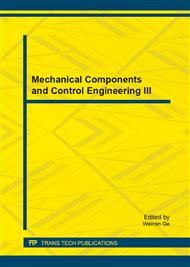[1]
Hongwu Qin, Gang Zhao, Qinyin Fan, Tongli Jia, Hao Du. The Nondestructive Testing Approach of Acoustic Emission for Environmentally Hazardous Objects. AEIT 2013, P474-477.
DOI: 10.1109/msn.2013.87
Google Scholar
[2]
Pelrine, R., P. Sommer-Larsen, R. Kornbluh, R. Heydt, G. Kofod, Q. Pei, and P. Gravesen. Applications ofDielectric Elastomer Actuators, Smart Structures and Materials 2001: Electroactive Polymer Actuators and Devices, ed. Y. Bar-Cohen, Proc. SPIE, Vol. 4329, p.335–349, (2001).
DOI: 10.1117/12.432665
Google Scholar
[3]
Kornbluh, R., R. Pelrine, Q. Pei, and V. Shastri, Application of Dielectric EAP Actuators, Electroactive Polymer(EAP) Actuators as Artificial Muscles—Reality, Potential and Challenges, ed. Y. Bar-Cohen, SPIE Press, Bellingham, Washington, p.457–495, (2001).
DOI: 10.1117/3.547465.ch16
Google Scholar
[4]
Sommer-Larsen, P., J. Hooker, G. Kofod, K. West, M. Benslimane, and P. Gravesen, Response of dielectric elastomer actuators, Smart Structures and Materials 2001: Electroactive Polymer Actuators and Devices, ed. Yoseph Bar-Cohen, Proc. SPIE 4329, p.157–163, (2001).
DOI: 10.1117/12.432641
Google Scholar
[5]
Pelrine, R., R. Kornbluh, and G. Kofod, High-Strain Actuator Materials Based on Dielectric Elastomers, Advanced Materials 2000 12: 16, p.1223–1225, (2000).
DOI: 10.1002/1521-4095(200008)12:16<1223::aid-adma1223>3.0.co;2-2
Google Scholar
[6]
Pei, Q., M. Rosenthal, R. Pelrine, S. Stanford, and R. Kornbluh, Multifunctional electroelastomer actuators and their application for biomimetic walking robots, Smart Structures and Materials 2003: Electroactive Polymer Actuators and Devices (EAPAD), ed. Y. Bar-Cohen, Proc. SPIE 5051, p.281–290, (2003).
DOI: 10.1117/12.484392
Google Scholar
[7]
Hongwu Qin, Haifu Li, Xiaoli Wang. Hardware-software complex of transfer analysis features of NDT objects. ICMECE 2012, Applied Mechanics and Materials2013, V313-314: 1311-1315.
DOI: 10.4028/www.scientific.net/amm.313-314.1311
Google Scholar
[8]
Hongwu Qin, Nianfeng Li, Chunfeng Li. Spectral Analysis of Acoustic Emission Signals Using NI Systems. HSME 2012, Advanced Materials Research 2013, V 663: 507-510.
DOI: 10.4028/www.scientific.net/amr.663.507
Google Scholar
[9]
Hongwu Qin, Xiaoli Wang, Qinsheng Du. Research of special form for analysis properties in transmit channels of NDT system. ICMECE 2012, Applied Mechanics and Materials (2013), Vol. 313-314, pp.1316-1319.
DOI: 10.4028/www.scientific.net/amm.313-314.1316
Google Scholar
[10]
Sommer-Larsen, P., and R. Kornbluh, Polymer Actuators, Proc. Actuator 2002, 8th International Conf. on New Actuators, Bremen, Germany (June), p.371–378, (2002).
Google Scholar


